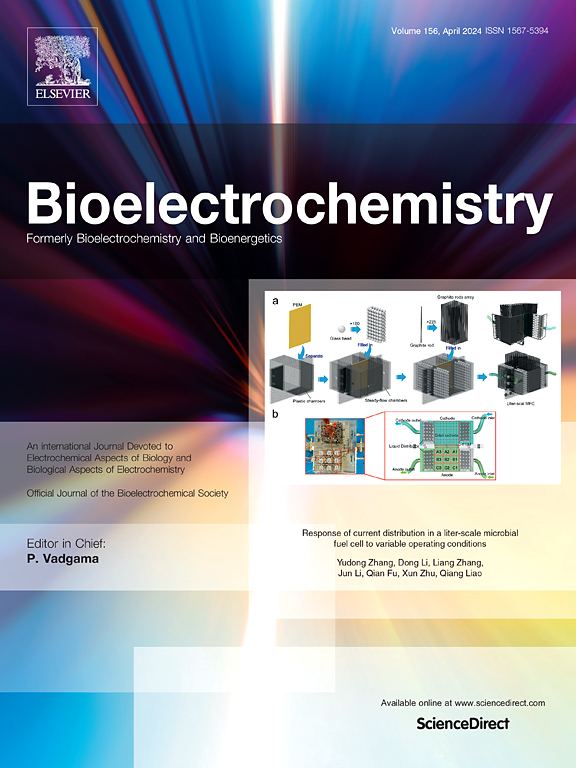Investigation of acetate uptake kinetics of mature Geobacter sulfurreducens biofilms in continuous bioelectrochemical systems reveals unexpected challenges
IF 4.8
2区 化学
Q1 BIOCHEMISTRY & MOLECULAR BIOLOGY
引用次数: 0
Abstract
Mature Geobacter sulfurreducens biofilms cultivated at two distinct anode potentials, representing unlimited and limited electron acceptor availability, were subjected to different acetate concentrations in a continuous reactor system. The Nernst-Michaelis-Menten equation, being modified to consider the conditions of a continuous stirred-tank reactor, was applied to analyze the acetate uptake kinetics. For the first time, the kinetics of pure G. sulfurreducens biofilms based on quantification of the acetate consumption were determined. Acetate uptake parameters ( = 1.41 ± 0.42 mM, = 1.10 ± 0.12 mmolAc− h−1 gDW−1, n = 4) obtained from cultivation at 0.4 V (vs. SHE), showed significant differences compared to an approach that derived acetate uptake parameters from the current production. This deviation is likely related to the coulombic efficiency, which exhibited a dependence on the acetate concentration. The coulombic efficiency was 30–50 % for acetate concentrations <1 mM, and saturated at 78.6 ± 4.0 % for more than 2 mM acetate. Despite the Nernst-Michaelis-Menten equation being developed to cover limiting terminal electron acceptor conditions, its application to biofilms cultivated at −0.1 V yielded contradictory results indicating application limits. Considering the complexity and plasticity of acetate uptake kinetics together with the complex extracellular electron transfer machinery, Geobacter sulfurreducens biofilms are a model system that is shown to provide unexpected challenges and demanding highly controlled experimental conditions.

对连续生物电化学系统中成熟的硫发生地杆菌生物膜吸收醋酸盐动力学的研究揭示了意想不到的挑战
在代表无限和有限电子受体可用性的两种不同阳极电位下培养的成熟硫还原地杆菌生物膜,在连续反应器系统中受到不同醋酸浓度的影响。修正了Nernst-Michaelis-Menten方程,考虑了连续搅拌槽反应器的条件,应用该方程分析了乙酸盐的摄取动力学。本文首次通过定量测定硫酸还原g生物膜的乙酸耗量,对其动力学进行了研究。在0.4 V (vs. SHE)下获得的乙酸吸收参数(KM,Ac = 1.41±0.42 mM, vmax,Ac = 1.10±0.12 mmolAc−h−1 gDW−1,n = 4)与从当前生产中获得乙酸吸收参数的方法相比有显著差异。这种偏差可能与库仑效率有关,而库仑效率与乙酸盐浓度有关。当乙酸浓度为1 mM时,库仑效率为30 - 50%;当乙酸浓度大于2 mM时,库仑效率为78.6±4.0%。尽管Nernst-Michaelis-Menten方程被开发用于覆盖限制终端电子受体条件,但其在−0.1 V培养的生物膜上的应用产生了矛盾的结果,表明应用限制。考虑到醋酸盐摄取动力学的复杂性和可塑性以及复杂的细胞外电子转移机制,硫还原Geobacter硫还原生物膜是一个模型系统,它被证明提供了意想不到的挑战和要求高度控制的实验条件。
本文章由计算机程序翻译,如有差异,请以英文原文为准。
求助全文
约1分钟内获得全文
求助全文
来源期刊

Bioelectrochemistry
生物-电化学
CiteScore
9.10
自引率
6.00%
发文量
238
审稿时长
38 days
期刊介绍:
An International Journal Devoted to Electrochemical Aspects of Biology and Biological Aspects of Electrochemistry
Bioelectrochemistry is an international journal devoted to electrochemical principles in biology and biological aspects of electrochemistry. It publishes experimental and theoretical papers dealing with the electrochemical aspects of:
• Electrified interfaces (electric double layers, adsorption, electron transfer, protein electrochemistry, basic principles of biosensors, biosensor interfaces and bio-nanosensor design and construction.
• Electric and magnetic field effects (field-dependent processes, field interactions with molecules, intramolecular field effects, sensory systems for electric and magnetic fields, molecular and cellular mechanisms)
• Bioenergetics and signal transduction (energy conversion, photosynthetic and visual membranes)
• Biomembranes and model membranes (thermodynamics and mechanics, membrane transport, electroporation, fusion and insertion)
• Electrochemical applications in medicine and biotechnology (drug delivery and gene transfer to cells and tissues, iontophoresis, skin electroporation, injury and repair).
• Organization and use of arrays in-vitro and in-vivo, including as part of feedback control.
• Electrochemical interrogation of biofilms as generated by microorganisms and tissue reaction associated with medical implants.
 求助内容:
求助内容: 应助结果提醒方式:
应助结果提醒方式:


